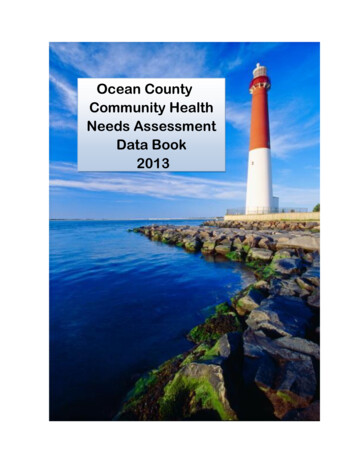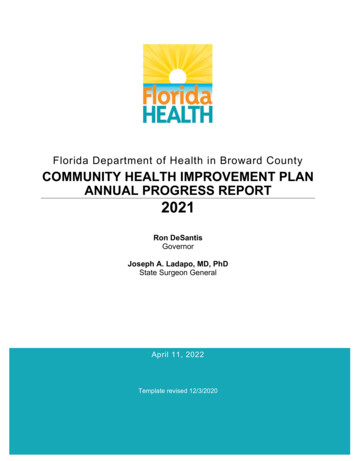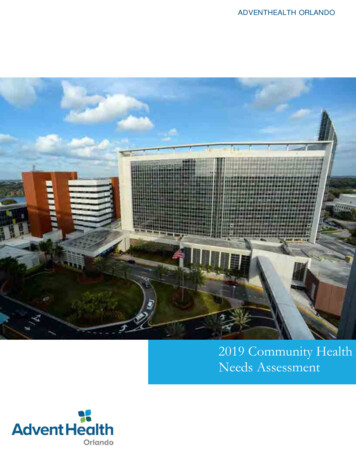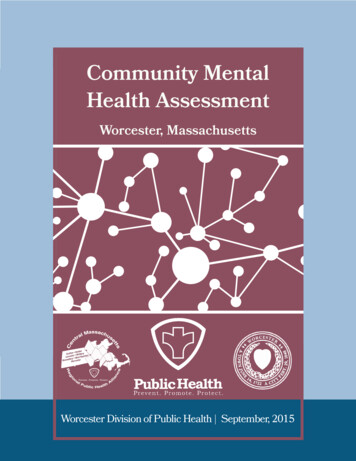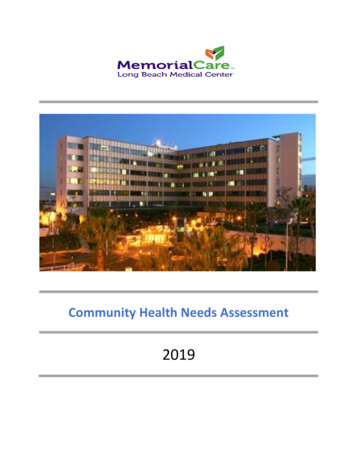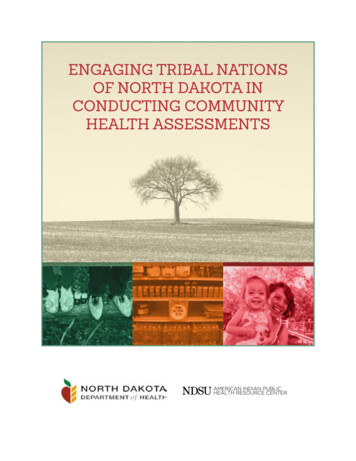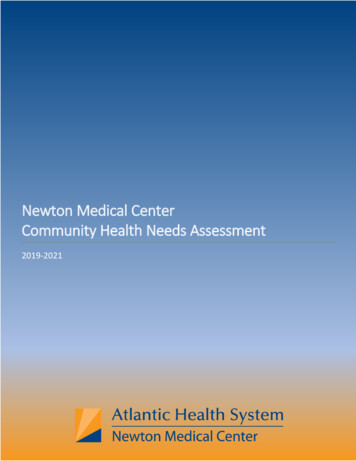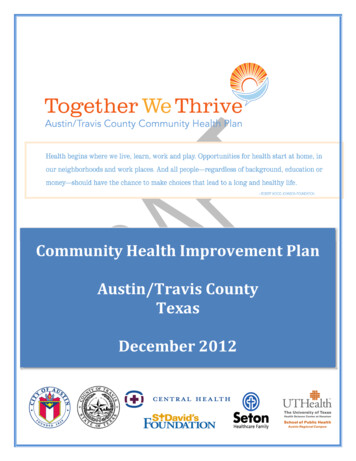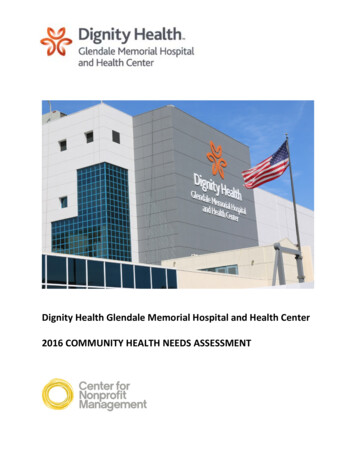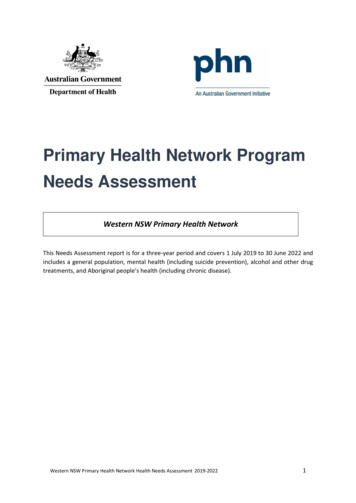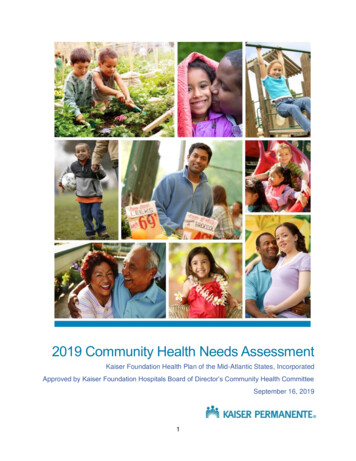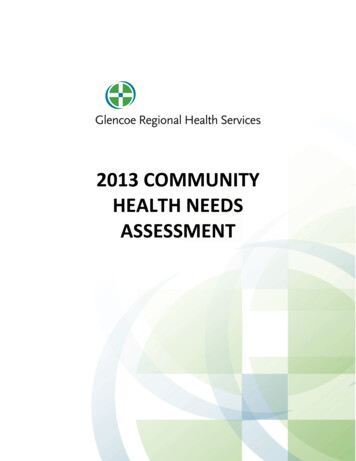
Transcription
2013 COMMUNITYHEALTH NEEDSASSESSMENT1
2013 CHNATABLE OF CONTENTSCEO’s Letter to the Community . 3Executive Summary . 4Community Served . 5Demographics . 6Health Status . 6Assessment Process and Methodology . 7Community Health Needs Identified . 8Action Planning . 13Implementation Strategy . 13CHNA Availability . 14Appendix. 15Appendix A (Primary Service Area) . 15Appendix B (Total Population) . 16Appendix C (Population by Age) . 17Appendix D (Population in Poverty). 18Appendix E (Population Receiving Medicaid) . 19Appendix F (Unemployment Rate). 20Appendix G (Physical Inactivity) . 21Appendix H (Tobacco Usage) . 22Appendix I (Diabetes Prevalence) . 23Appendix J (Heart Disease Prevalence). 24Appendix K (Heart Disease Mortality). 25Appendix L (Cancer Mortality) . 26Appendix M (Teen Births) . 27Appendix N (Low Birth Weight) . 28Appendix O (Mothers Receiving Prenatal Care in 1st Trimester) . 292
2013 CHNADear Community:On behalf of the medical staff and employees at Glencoe Regional Health Services, I would liketo extend our sincere thanks for the opportunity to care for you, your friends and your familyover the years. Our mission at Glencoe Regional Health Services is to provide high quality,convenient and personal health care to those we serve. We do so by providing comprehensive,evidence-based, cost-effective health care services and education. We collaborate with othersto coordinate and improve the health of our communities, and commit our skills and resourcesto benefit the whole person through all stages of life.Glencoe Regional Health Services strives to be the health care provider of choice and employerof choice in our area. Our core values include: CompassionAuthenticityRespectExcellenceServiceTo support the fulfillment of our mission and vision as a nonprofit hospital, as well as meet therequirements enacted by the 2010 Patient Protection and Affordable Care Act, GlencoeRegional Health Services has conducted a community health needs assessment (CHNA). A CHNAis essentially a review of current health activities, resources, initiatives, gaps and limitations toidentify areas of improvement.We are pleased to present you with the results of our 2013 CHNA. We invite your feedback andcomments on our current CHNA, as your input will help guide and impact our next CNHA whichwill be undertaken again in three years.Sincerely,Jon D. Braband, FACHEPresident and CEO3
2013 CHNAExecutive SummaryGlencoe Regional Health Services (GRHS) is required to conduct a Community Health NeedsAssessment (CHNA) and adopt an implementation strategy to meet the community healthneeds identified through the CHNA at least once every three years. The following documentand past and future activities described therein serve to meet that requirement.The majority of the hospital facility’s CHNA process occurred in mid-2013. The CHNA was acollaborative process involving four hospitals, public health, other community service agenciesand public bodies, plus community representatives, coordinated by a facilitator fromStratisHealth. The process consisted of two half-day workshops, held on May 22 and June 5.The three highest‐priority health needs for the community served by GRHS were identified as 1)mental health, 2) obesity prevention, and 3) prevention/wellness.The GRHS Board of Directors reviewed the health status statistics and trends for GRHS’ servicearea. The Board also reviewed the ranked priorities as developed by the community forumprocess. Based upon an analysis of GRHS’s capabilities and capacity, it was determined that wewould focus on mental health as the key area to address during the next three years. This willbe addressed by providing additional mental health counseling services. This plannedintervention will be monitored over time to determine its effectiveness and whether thecommunity needs are being addressed in this area.We truly believe this CHNA and associated implementation strategy will benefit communityhealth, thus supporting Glencoe Regional Health Services’ mission of providing comprehensive,high quality, cost effective, community-based, health care services to the residents of thecommunities we serve.We welcome and invite feedback on our CHNA. Comments on the CHNA and its accompanyingimplementation strategy can be emailed to GRHS at CHNA.comments@grhsonline.org.4
2013 CHNACommunity ServedGRHS determined its service area by reviewing patient origin, essentially looking at where themajority of its patients come from over time. This has been fairly stable over a four year period,as noted in Table 1. For the purpose of this CHNA, the primary service area of Glencoe RegionalHealth Services has been determined to be McLeod County, from which approximately 70% ofits patients come.Table 1Total Hospital AdmissionsCity/Zip Code2009201020112012GLENCOE - 5533641.9%44.5%41.5%43.5%STEWART - 553852.1%1.7%3.5%2.8%GAYLORD - 553345.3%7.3%6.0%6.0%LESTER PRAIRIE - 553546.1%4.1%6.5%5.6%BROWNTON - 553125.5%3.2%3.4%3.3%HUTCHINSON - 553508.5%9.1%9.1%10.1%ARLINGTON - 553075.2%5.3%5.6%5.4%WINSTED - 553954.1%4.5%2.6%2.2%SILVER LAKE - 553812.0%2.3%2.4%2.9%PLATO - 553701.6%0.9%1.0%1.4%NEW AUBURN - 553661.2%0.5%1.8%0.9%NORWOOD-YOUNG AMERICA - 55368/553971.9%1.7%2.4%0.7%GREEN ISLE - 553381.6%0.6%1.6%1.0%HAMBURG - 553390.2%0.2%0.2%0.7%BUFFALO LAKE - od County:71.8%70.3%70.0%71.8%Non-McLeod 100.0%A map of GRHS’ primary service area is also available in the appendix at the end of this report.See Appendix A.5
2013 CHNADemographicsAn evaluation of available demographic data from the U.S. Census Bureau shows the following: McLeod County is relatively more dense than Minnesota (74.7 persons per square mileversus 66.3 persons per square mile, respectively), but less dense than the U.S. as awhole (at 87.9 persons per square mile).McLeod County is slightly “older” than both Minnesota and the U.S., with the over-65age group being 14.9% for McLeod County, 12.7% for Minnesota and 12.9% for the U.S.The McLeod County population is less poor than Minnesota and the U.S. (with 7.5%being below the Federal Poverty Level in McLeod County, 11.0% in Minnesota, and14.7% in the U.S.).Relatively fewer residents of McLeod County receive Medicaid than Minnesota as awhole or the U.S. (with 12.5%, 14.0% and 16.6% of the population on Medicaid,respectively).See Appendix B, C, D, and E.In addition, information available from the U.S. Department of Labor’s Bureau of LaborStatistics shows that the unemployment rate in McLeod County is slightly higher compared toMinnesota as a whole (5.5% versus 5.1%), but lower than the U.S. unemployment rate (at7.7%). See Appendix F.Health StatusAn evaluation of health status indicators from the Centers for Disease Control and Prevention(CDC) shows that residents of McLeod County are relatively more physically active thanMinnesota as a whole (19.1% reporting no leisure time physical activity, versus 19.8%,respectively), and more active than the U.S. population as a whole (23.8% reporting no leisuretime physical activity). It also shows: Fewer McLeod County residents report using tobacco products (12.4%) than Minnesotaas a whole (17.1%) or the U.S. population (18.6%).Residents of McLeod County have relatively similar prevalence of diabetes as the Stateof Minnesota (7.8% and 7.5%, respectively), and less than the U.S. population (9.6%).McLeod County and Minnesota have similar prevalence rates of heart disease (3.9% and3.7%, respectively), and less than the U.S. (4.3%).Heart disease mortality is similar in McLeod County and Minnesota (age adjusted ratesof 79.3 and 76.0 per 100,000 population, respectively), both of which are far less thanthe mortality rate for the U.S. (134.7 per 100,000).Residents of McLeod County have a lower cancer mortality rate than Minnesota as awhole or the U.S. population (age adjusted rate of 154.8 for McLeod County comparedto 169.0 and 176.7 respectively).See Appendix G, Appendix H, Appendix I, Appendix J, Appendix K and Appendix L.6
2013 CHNAInformation available from the CDC shows that McLeod County has relatively more teen birthsthan the State of Minnesota as a whole (33.0 per 1,000 births, versus 26.8 per 1,000,respectively), but less than the U.S. rate (at 41.2 per 1,000). McLeod County has fewer babiesborn with low birth weights (5.3%) than Minnesota (6.5%) or the U.S. (8.1%). In addition,information available from the Minnesota Department of Health’s Center for Health Statisticsindicates that relatively more expectant mothers receive prenatal care in their first trimester ofpregnancy in McLeod County (89.5%) than the State of Minnesota as a whole (86.0%). SeeAppendix M, Appendix N, and Appendix O.Assessment Process and MethodologyThe CHNA assessment process utilized by GRHS was a collaborative effort coordinated throughthe Meeker, McLeod, Sibley Healthy Communities Leadership Team (CLT). This group planned afocus group/workshop approach, in which participants from a variety of area agencies andbusinesses were invited to participate in two, half-day planning sessions. Under the auspices ofa grant from Stratis Health (Minnesota’s designated Quality Improvement Organization, or“QIO”), Kim McCoy, MPH, MS, served as the project planner and facilitator. Active participantsand planning agents in the process included the four hospitals serving the McLeod, Meeker andSibley counties: Glencoe Regional Health Services (Glencoe – McLeod County), HutchinsonHealth (Hutchinson – McLeod County), Meeker Memorial Hospital (Litchfield – Meeker County)and Sibley Medical Center (Arlington – Sibley County).Invitations to participate in the two half-day workshops were sent out to over 100 people andagencies in the three-county area, representing public health, education, business, localgovernment and other community service agencies. Approximately 60 individuals participatedin the two focus group sessions, which were held on May 25 and June 5, 2013, in centrallylocated Hutchinson. Participants included representatives from the City of Hutchinson, GFWSchools, Glencoe Regional Health Services, Heartland Community Action Agency, HutchinsonHealth, Litchfield Chamber of Commerce, McLeod County Board of Commissioners, McLeodCounty Food Shelf, McLeod County Human Services, Meeker County Highway Department,Meeker County Public Health, Meeker-McLeod-Sibley Community Health Services, MeekerMemorial Hospital, Minnesota Rubber and Plastics, Sibley County Board of Commissioners,Sibley County Public Health, Sibley East Schools, Sibley Medical Center, University of MinnesotaExtension – Meeker, McLeod, Sibley Counties, and other local businesses. It was felt that theneeds and interest of the medically underserved, low income and minority populations wereable to be represented through input from representatives from the McLeod County FoodShelf, County Public Health and Human Services, city and county government officials, andother community service agencies. The needs of the most significant minority population in thearea were also felt to be represented through participation by a Spanish interpreter employedby Glencoe Regional Health Services.7
2013 CHNACommunity Health Needs IdentifiedDuring the two-day focus group process, the group first reviewed and evaluated data on therelative health status of the area, including historical data on age, race, language and income,disease-specific indicators and relative access to health care services. The group next focusedon the question, “What are our communities’ biggest health care problems?” The collaborativegroup developed a list of ten topics that were felt to have a potential impact upon the healthstatus of the area’s population. Through conversations and the review of current data, tentopics were identified as having links to health outcomes. These included: Access to Health CareChronic DiseaseCollaboration between organizationsMental HealthObesity preventionParent/Family SupportPrevention and WellnessSenior Services/SupportSubstance AbuseTeensBelow are the complete findings:Access to Health Care Current Activities or ResourcesPublic health – dental varnishing, countybased purchasing care vans, Child and TeenCheckups, lead testing at WIC (Women,Infants and Children), immunizationsMental health services in schoolsCase management services for elderlythrough county agenciesHealth care agencies in all counties –hospitals and clinicsAll 3 counties have pharmaciesMA and MN Care for some county residents Gaps and LimitationsLack of transportation for some peopleDental care limited for some populations dueto moneyLack of mental health providersMedical insurance not available to allMedical insurance doesn’t cover all costs foreveryonePediatric care – access to servicesLack of identification before crisis (hard to beproactive; often find out too late)Opportunities for collaboration acrosssettingsDifficulty navigating the systemLack of trained health care interpreters8
2013 CHNAChronic Disease Current Activities or ResourcesDiabetes educationBlood pressure readingsChronic disease self-management (McLeod)Church – nurses offering general educationCommunity measurements – depression,asthma, diabetesMonthly community educationHome health careCommunity Health Improvement Plan (CHIP)Case management – health plansHutch Health – pre-diabetes classes, wellnessscreenings for community Gaps and LimitationsKnowing about events/services and get theword outFunding/time of educators/nurses/volunteersTransportationEducating on programs and getting people togoMotivating people to take part in their careIncrease screenings for chronic diseaseLow participation in case managementprogramCollaboration Between Organizations Current Activities or ResourcesHeart of HutchSHIP (Statewide Health ImprovementProgram)- networkingMental health – PACT (Putting AllCommunities Together) for FamiliesCollaborative (Meeker/McLeod)Cooking classes – U of M, Salvation Army,McLeod Social ServicesMCCC – Meeker County Care ConnectionsAAA – Senior ServicesWellness – Meeker/McLeod businessHunger Solutions – food shelvesParenting – Parent Support OutreachProgram, Head StartDental – Rice Regional Dental ClinicTransit – all 3 countiesHousing – HeartlandDisaster planning Gaps and LimitationsEducation and awareness that resources areavailable (public)Access to resourcesGovernment regulations that restrict fundinguse (e.g., target populations, demographics,county boundaries, etc.)Direct service staff are not knowledgeableabout resourcesHunger – bust myths for elderly re: SNAP(Supplemental Nutrition Assistance Program)and other social service programsTurf warsFundingLack of time to coordinate9
2013 CHNAMental Health Current Activities or ResourcesHutchinson Health – 12-bedinpatient/outpatient, 24-hour crisis lineMeeker Memorial – senior behavioral unitStepping StonesWoodland CentersCrow River CounselingJonas CenterLighthouse CounselingNew BeginningsSchools (high schools, colleges)Lutheran Social ServicesSocial Services Case ManagementPact for Families (McLeod and Meeker)Informal services, e.g., clergy, public health.,support groupsGeneral practitionersBirthrightCommon CupEAPs (Employee Assistance Programs)Catholic CharitiesSchool-linked mental health grantsText 4 LifeGaps and Limitations CapacityLimited specialties (e.g., children’s mentalhealth, chemical dependency, eatingdisorders)TransportationFunding and reimbursementUnderinsured, uninsured, MA populationStigmaFamily choice not to seek helpLong wait times for appointmentsLack of trained health care interpretersObesity Prevention Current Activities or ResourcesClinic quality improvement re: BMI readingsand MD counselingFarmers Markets (increasing number)School lunch program mandatesGSL/Hutch School gardens“Kitchen Kamp” – Extension/SS work withfamiliesWorksite Wellness – “challenges”Trails/parks/maps – collaborate with highwaydepartment and parksCommunity education/summer programmingEducation/screenings – health fairs, county fairTaste testing at WIC – more healthy choices Gaps and LimitationsKnowledge of what other agencies/entitiesare doingLimited resources - dedicated staff forpromotionCan’t make people take advantage ofprograms availableSocietal change re: family eatingpatterns/expectationsLack of adequate social media marketing(Twitter, FB, etc)Activities for kids not related to competitionjust to be physically activeGender-based10
2013 CHNAParent/Family Support Current Activities or ResourcesEarly education – ECFE (Early Childhood FamilyEducation), HS/EHS, preschool, WIC, Watch MeGrow, MOPS (Mothers of Preschoolers),Extension servicesMentoring of young families – public health, WIC,MOPS, CPS/SS programsSupport to young families – WIC, Common Cup(misc. faith-based)Growing up healthy – EAP (employee assistancecounseling through health insurance/employer),pediatricians, mental health providers, schoolcounseling, psychiatry, social workers, nurse, Farefor All grocery programHousing/finance/transportation/access toservices – Heartland, social services, public transit(fee) Gaps and LimitationsServices often income- or fee-basedHours of service limited to daytimeLack of awarenessExtended waiting time for mental healthcounselingLack of adolescent support groupsNo Big Brother/Big Sister YMCA programsDecreased daily living skills teaching atschoolsServices across the board for middle classPrevention and WellnessCurrent Activities or ResourcesWork site wellness SHIP funding (MMS) Innovative programs Collaborative servicesPreventing health screenings and rates Mobile dental and medical van – Sibley Active partnership grant – McLeod Direct access (reduced lab testing cost) –Meeker Migrant health (mobile) – Meeker, McLeod,Sibley & Kandiyohi CountiesImmunizations MN vaccines for kids Sliding fee scales School and public health collaboration MIIC database (MN Immunization InformationConnection)Gaps and LimitationsWork site wellness Funding and staffingPreventing health screenings and rates Education Cost Access and follow-up care Funding/coverage of serviceImmunizations Education Cost for adults Access11
2013 CHNASenior Services/Support Current Activities or ResourcesEducational opportunities – hospital andcommunity education, library programming,AAA (caregiver support, falls prevention,chronic disease management)Physical activity/fitness – Silver Sneakers,Bone BuildersEnd of life services – hospice, skilled nursingfacilities, specialized dementia careHousing options (housing with and withoutservices)Socialization opportunities within city limits(nutrition programs, senior centers, etc)Senior dining/Meals on WheelsHome health care Gaps and LimitationsGeneral awareness of services available –health plan-covered fitness plans,independent living skills to stay at homeTransportation – assistive transportation thatis affordable (aging lacks confidence requiredfor public system access)Access to grocery delivery is limitedPharmacy – limited delivery of prescriptionmedicationsSocialization opportunities (awareness of andtransportation to)Resistance to accepting helpSubstance Abuse Current Activities or ResourcesD.A.R.E. programPrevention and Intervention grant – SibleyCounty Partnering in PreventionProject Harmony (Pregnant women/moms)Winsted: Resource and RecoveryCommunity support groups (AA and NA)WINGS – teen chemical dependencyGlencoe Regional Health Services –interpretersSocial servicesPublic messaging/public serviceannouncementsResponsible server trainingLAMP (Litchfield Area Mentorship Program)LARPP (Litchfield Area Rural Partners inPrevention)Hutchinson HealthMEADA (Methamphetamine Education andDrug Awareness Coalition of McLeod County)Corrections treatment programToward 0 DeathsZAP (Zero Adult Provider) Gaps and LimitationsD.A.R.E. – expand age groups, increase lawenforcement engagement with kidsVolunteers in programsParental involvementLack of community engagementKnowledge regarding community resourcesLack of interpretersSynergy among organizationsFinancial resourcesSocial stigma12
2013 CHNATeens Current Activities or ResourcesYouth groups – church support (Hutchinson)Schools – speakers/presentationsAccess to activities – community garden,sports, FFA, Girl/Boy ScoutsPromise Neighborhood Institute– planning andprevention grantDrug Free Communities GrantCD counselors – hospitals, schoolsFamily planning grantHealth classesPlanned Parenthood Gaps and LimitationsDifficulty getting information to kids (schoolsnot ready, limited time)Smaller communities fewer activities, fewerchurches, fewer opportunitiesHealth classes – start early – self-esteem, etc(strengthen curriculum)Barriers in readiness, open to discussion,family reluctance/not ready forcommunicationLack of things to do – jobs, entertainmentTeens don’t know how to talk to adultsLack of therapistsAction PlanningUpon reviewing the top ten leading health care indicators, a list of criteria was created to assessthe areas most needing improvement in our community. The goal was to then determine thetop three topics for developing plans to implement change in the community. The decisionmaking criteria included: AffordabilitySustainabilityCan we make an impact?Is it realistic?Is there support already in place?With whom can we collaborate for abigger impact? Is the community ready to engage?Data/ability to measure changeAwareness of what is changing beyond 3 yearsSupport of leadershipLegislative/county commissioner supportMultiple impact points/overlap with multipleareasUsing the above decision making criteria, the group voted and identified Mental Health (26votes), Obesity Prevention (21 votes) and Prevention/Wellness (20 votes) as the top three areasupon which to focus future efforts.Implementation StrategyThe Glencoe Regional Health Services Board of Directors reviewed the intake process andrecommendations of the collaborative and approved an implementation strategy on November25, 2013. Based upon an analysis of organizational capability, it was determined that the bestimpact could be made by addressing the mental health needs of the community (the mostsignificant need as determined by the focus group process).13
2013 CHNAGRHS intends to address this community need by making more mental health counselingservices available. The planned approach is to provide psychiatric services through a contractedthird-party provider, via telemedicine. The anticipated start of this service is no later thanMarch, 2014. This intervention will be monitored over time to determine its effectiveness andwhether the community needs are being addressed in this area. We will assess utilization as aproxy measure of acceptance of the service. The assumption will be that use of the service willhave a positive impact on the overall mental health status of the patients of the community.Regarding the other top two identified needs, it was determined that obesity prevention andprevention/wellness can be addressed on a per-patient basis during one-on-one encounterswith GRHS medical providers. It was also determined that GRHS will evaluate avenues tocollaborate with other community agencies to address these issues as these opportunitiespresent themselves.CHNA AvailabilityThis report is available on the Glencoe Regional Health Services website:www.grhsonline.org/chna. Paper copies are also available without charge upon request.Comments and suggestions are welcome, and may be submitted via email toCHNA.comments@grhsonline.org.14
2013 CHNAAppendix A15
2013 CHNAAppendix BTotal PopulationReport AreaMcLeod CountyMinnesotaUnited StatesTotal Population36,7195,278,190310,346,360Total Land Area(Square Miles)49179,6053,530,998Population Density(Per Square Mile)74.766.387.9Data Source: U.S. Census Bureau, American Community Survey, 2007-11http://www.census.gov/acs/www/16
2013 CHNAAppendix CTotal Population by Age GroupsReport AreaMcLeod CountyMinnesotaUnited StatesAge 0-179,2551,280,59674,047,748Age 18-4412,0891,910,791112,859,948Age 45-649,8891,414,30780,087,256Age 65 90306,603,768Data Source: US Census Bureau, American Community Survey: 2007-11.http://www.census.gov/acs/www/17
2013 CHNAAppendix DPopulation in PovertyReport AreaMcLeod CountyMinnesotaUnited StatesTotal Population36,0855,155,949289,788,000Population inPoverty2,701565,15442,739,924Percent Population in Poverty(100% FPL)7.5%11.0%14.7%Data Source: US Census Bureau, American Community Survey: 2007-11.http://www.census.gov/acs/www/18
2013 CHNAAppendix EPopulation Receiving MedicaidReport AreaMcLeod CountyMinnesotaUnited StatesTotal iving Medicaid4,570742,87751,335,184Percent PopulationReceiving Medicaid12.5%14.0%16.6%Data Source: US Census Bureau, American Community Survey: 2009-11.http://www.census.gov/acs/www/19
2013 CHNAAppendix FUnemployment RateReport AreaMcLeod CountyMinnesotaUnited StatesLabor 2,083,273Unemployment Rate5.5%5.1%7.7%Data Source: US Department of Labor, Bureau of Labor Statistics: 2013-August.http://www.bls.gov/20
2013 CHNAAppendix GPhysical Inactivity (Adult)Report AreaMcLeod CountyMinnesotaUnited StatesTotal PopulationAge 20 26,5393,881,016226,142,005Population with noLeisure TimePhysical Activity5,069770,30153,729,295Percent Population withNo Leisure Time PhysicalActivity19.1%19.8%23.8%Data Source: Centers for Disease Control and Prevention, National Center for Chronic Disease Prevention andHealth Promotion, Diabetes Atlas: atlas.html21
2013 CHNAAppendix HTobacco UsageReport AreaMcLeod CountyMinnesotaUnited StatesTotal Population Age 18 27,3193,959,836229,932,154Estimated PopulationRegularly SmokingCigarettes3,388677,13142,664,071Percent EstimatedPopulation RegularlySmoking Cigarettes12.4%17.1%18.6%Data Source: Centers for Disease Control and Prevention, Behavioral Risk Factor Surveillance System: 200511. http://www.cdc.gov/brfss/22
2013 CHNAAppendix IDiabetes PrevalenceReport AreaMcLeod CountyMinnesotaUnited StatesTotal Population Age20 26,5003,887,041228,834,127Population withDiagnosed Diabetes2,067289,61421,876,232Percent Populationwith DiagnosedDiabetes7.8%7.5%9.6%Data Source: Centers for Disease Control and Prevention, National Center for Chronic Disease Preventionand Health Promotion, Diabetes Atlas: atlas.html23
2013 CHNAAppendix JHeart Disease PrevalenceReport AreaMcLeod CountyMinnesotaUnited StatesTotal PopulationAge 18 27,3193,997,594235,375,690Total Adults withHeart Disease1,079149,05010,183,713Percent Adults with HeartDisease3.9%3.7%4.3%Data S
health, thus supporting Glencoe Regional Health Services’ mission of providing comprehensive, high quality, cost effective, community-based, health care services to the residents of the communities we serve. We welcome and invite feedback on our CHNA. Comments on the CHNA and its accom
